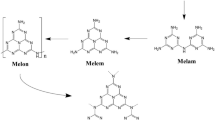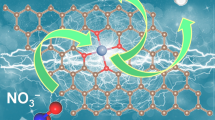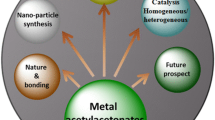Abstract
Developing a chemoselective catalyst for the acetalation of biomass-derived glucose to alkyl glycosides has been recognised as an emerging field due to its wide range of applications. The present study focuses on synthesising sulfate functionalised niobium oxide-based (NbOx-DS) catalyst to introduce medium/strong acidic sites that contribute to the catalytic activity towards glucose acetalation, which has not been explored previously. The nanosized NbOx-D is prepared via a precipitation approach using niobium chloride and diethylamine as a precursor and precipitating agent, respectively. The sulfate groups incorporated NbOx-DS gives a good yield of ethyl glucosides (60%) with excellent selectivity (97%) in ethanol. On the other hand, the sulfate groups incorporated into the commercial niobium oxide (NbOx-CS) exhibits poor catalytic activity, yielding 6% ethyl glucoside with a low selectivity (8%). FTIR analysis corroborates the incorporation of sulfate groups in the NbOx-DS matrix, unlike NbOx-CS. XRD pattern of NbOx-DS shows a lower angle shift of a peak to 23.5° compared to parent NbOx-D (24.32°), indicating lattice expansion due to the incorporation of sulfate groups, and no such a shift in the case of NbOx-CS is observed. NH3-temperature programmed desorption (NH3-TPD) reveals that NbOx-DS possess a 2.1-fold higher number of acidic sites than NbOx-D, whereas NbOx-CS possess a negligible number of acidic sites, indicating the significance of the synthesis procedure of NbOx-D for efficient incorporation of sulfate groups. NbOx-DS displays recyclability for at least three runs with minor loss in the activity. In a nutshell, the current study reflects that NbOx-DS obtained via precipitation followed by sulfate groups incorporation increases the medium/strong acidic sites, which contributes significantly to enhancing the ethyl glucoside selectivity (97%).
Graphical Abstract










Similar content being viewed by others
References
Corma A, Iborra S, Velty A (2007) Chemical routes for the transformation of biomass into chemicals. Chem Rev. https://doi.org/10.1021/cr050989d
Besson M, Gallezot P, Pinel C (2014) Conversion of biomass into chemicals over metal catalysts. Chem Rev. https://doi.org/10.1021/cr4002269
Climent MJ, Corma A, Iborra S (2011) Heterogeneous catalysts for the one-pot synthesis of chemicals and fine chemicals. Chem Rev. https://doi.org/10.1021/cr1002084
Lange JP (2015) Renewable feedstocks: the problem of catalyst deactivation and its mitigation. Angew Chem. https://doi.org/10.1002/anie.201503595
Lange JP (2016) Catalysis for biorefineries—performance criteria for industrial operation. Catal Sci Technol. https://doi.org/10.1039/C6CY00431H
Ragauskas AJ, Williams CK, Davison BH, Britovsek G, Cairney J, Eckert CA, Frederick WJ, Hallett JP, Leak DJ, Liotta CL, Mielenz JR, Murphy R, Templer R, Tschaplinski T (2006) The path forward for biofuels and biomaterials. Science. https://doi.org/10.1126/science.1114736
Holm MS, Saravanamurugan S, Taarning E (2010) Conversion of sugars to lactic acid derivatives using heterogeneous zeotype catalysts. Science. https://doi.org/10.1126/science.1183990
Aggarwal N, Yatoo MA, Saravanamurugan S (2020) Glucose oxidation to carboxylic products with chemocatalysts. Biomass Biofuel Biochem. https://doi.org/10.1016/B978-0-444-64307-0.00002-0
Kumar S, Devi MM, Kansal SK, Saravanamurugan S (2020) Untangling the active sites in the exposed crystal facet of zirconium oxide for selective hydrogenation of bioaldehydes. Catal Sci Technol. https://doi.org/10.1039/D0CY01259A
Kumar S, Ali H, Kansal SK, Pandey A, Saravanamurugan S (2020) Sustainable production of sorbitol-a potential hexitol. Biomass Biofuel Biochem. https://doi.org/10.1016/B978-0-444-64307-0.00009-3
Kumar S, Kansal SK, Pandey A, Saravanamurugan S (2022) Polyalkylglycosides: sustainable production of nonionic biosurfactants from lignocellulosic biomass. Biomass Biofuel Biochem. https://doi.org/10.1016/B978-0-12-824419-7.00009-1
https://librachem.co.uk/libra-products-surfactants/libracare-alkyl-polyglucosides/
https://www.galaxysurfactants.com/products/product-groups/mild-surfactants.aspx
https://librachem.co.uk/libra-speciality-chemicals-hii-cleaning-products/
Jerome F, Marinkovic S, Estrine B (2018) Transglycosylation: a key reaction to access alkylpolyglycosides from lignocellulosic biomass. Chemsuschem. https://doi.org/10.1002/cssc.201800265
Wolfgang VR, Karlheinz H (1998) Alkyl polyglycosides—properties and applications of a new class of surfactants. Angew Chem. https://doi.org/10.1002/(SICI)1521-3773(19980605)37:10%3c1328::AID-ANIE1328%3e3.0.CO;2-9
Ramdani WG, Karam A, Vigier KDO, Rio S, Ponchel A, Jerome F (2019) Catalytic glycosylation of glucose with alkyl alcohols over sulfonated mesoporous carbons. Mol Catal. https://doi.org/10.1016/j.mcat.2019.02.016
Ma Y, Tan W, Wang K, Wang J, Jiang J, Xu J (2017) An insight into the selective conversion of bamboo biomass to ethyl glycosides. ACS Sustain Chem Eng. https://doi.org/10.1021/acssuschemeng.7b00618
Donat R, Demirel V (2022) Synthesis of some alkyl polyglycosides. IJSM. https://doi.org/10.21448/ijsm.1033290
Okuhara T (2002) Water-tolerant solid acid catalysts. Chem Rev. https://doi.org/10.1021/cr0103569
Harmer MA, Sun Q, Vega AJ, Farneth WE, Heidekum A, Hoelderich WF (1999) Nafion resin-silica nano-composite solid acid catalysts. Green Chem. https://doi.org/10.1039/A907892D
Liu F, Huang K, Zheng A, Xiao FS, Dai S (2018) Hydrophobic solid acids and their catalytic applications in green and sustainable chemistry. ACS Catal. https://doi.org/10.1021/acscatal.7b03369
Wu Y, Yu JG, Ma XF, Zhang JS (2007) An efficient and facile procedure for synthesis of octyl polyglucoside. Chin Chem Lett. https://doi.org/10.1016/j.cclet.2007.07.023
Puga AV, Corma A (2017) Direct conversion of cellulose into alkyl glycoside surfactants. ChemistrySelect. https://doi.org/10.1002/slct.201700389
Zheng W, Cui Y, Xu Z, Zhao L, Sun W (2018) Cellulose transformation into methyl glucosides catalysed by H3PW12O40: enhancement of ionic liquid pretreatment. Can J Chem Eng. https://doi.org/10.1002/cjce.23057
Saravanamurugan S, Riisager A (2011) Solid acid catalysed formation of ethyl levulinate and ethyl glucopyranoside from mono- and disaccharides. Catal Commun. https://doi.org/10.1016/j.catcom.2011.10.001
Siril PF, Davison AD, Randhawa JK, Brown DR (2007) Acid strengths and catalytic activities of sulfonic acid on polymeric and silica supports. J Mol Catal A. https://doi.org/10.1016/j.molcata.2006.11.022
Chaugule AA, Jadhav AR, Kim H (2015) Polyvinyl trisulfonate ethylamine based solid acid catalyst for the efficient glycosylation of sugars under solvent free conditions. RSC Adv. https://doi.org/10.1039/C5RA20300G
Nakajima K, Baba Y, Noma R, Kitano M, Kondo JN, Hayashi S, Hara M (2011) Nb2O5 3 nH2O as a heterogeneous catalyst with water-tolerant lewis acid sites. J Am Chem Soc. https://doi.org/10.1021/ja110482r
Kitano T, Shishido T, Teramura K, Tanaka T (2013) Characterisation of thermally stable brønsted acid sites on alumina-supported niobium oxide after calcination at high temperatures. ChemPhysChem. https://doi.org/10.1002/cphc.201300189
Zhou S, Song Y, Zhao J, Zhou X, Chen L (2021) Study on the mechanism of water poisoning Pt-promoted sulfated zirconia alumina in n-hexane isomerisation. Energy Fuels. https://doi.org/10.1021/acs.energyfuels.1c01440
Hanaoka T, Takeuchi K, Matsuzaki T, Sugi Y (1990) Niobic acid as a solid acid catalyst for ring-opening reactions of phenyloxirane. Catal Today. https://doi.org/10.1016/0920-5861(90)87013-S
Heitmann AP, Rocha IC, Periera IM, Oliveira LCA, Patricio PSO (2019) Nanoparticles of niobium oxyhydroxide incorporated in different polymers for photocatalytic degradation of dye. J Polym Res. https://doi.org/10.1007/s10965-019-1824-3
Wu Z, Li C, Li Z, Feng K, Cai M, Zhang D, Wang S, Chu M, Zhang C, Shen J, Huang Z, Xiao Y, Ozin GA, Zhang X, He L (2021) Niobium and titanium carbides (MXenes) as superior photothermal supports for CO2 photocatalysis. ACS Nano. https://doi.org/10.1021/acsnano.1c00990?ref=pdf
Jones BMF, Mamba G, Maruthamani D, Muthuraj V (2022) Honeycomb Nb2O5/RGO wrapped on MoO3 nanorods for visible light-driven degradation of sulfasalazine and ciprofloxacin in water. Colloids Surf. https://doi.org/10.1016/j.colsurfa.2022.129836
Rangel EM, Riemke FC, Ucker CL, Raubach CW, Adebayo MA, Machado FM (2022) Photodegradation of acid yellow 23 by Nb2O5 supported on eco-friendly glass foams. J Clean. https://doi.org/10.1016/j.jclepro.2022.133231
Tagusagawa C, Takagaki A, Iguchi A, Takanabe K, Kondo JN, Ebitani K, Hayashi S, Tatsumi T, Domen K (2010) Highly active mesoporous Nb–W oxide solid-acid catalyst. Angew Chem. https://doi.org/10.1002/anie.200904791
Ishikawa S, Shinoda M, Motoki Y, Tsurumi S, Kimura M, Hiyoshi N, Yoshida A, Ueda W (2020) Synthesis of fluoride-containing high dimensionally structured Nb oxide and its catalytic performance for acid reactions. Inorg Chem. https://doi.org/10.1021/acs.inorgchem.0c00949
Yamashita K, Hirano M, Okumura K, Niwa M (2006) Activity and acidity of Nb2O5-MoO3 and Nb2O5-WO3 in the Friedel-Crafts alkylation. Catal Today. https://doi.org/10.1016/j.cattod.2006.07.025
Hegde V, Pandit P, Rananaware P, Brahmkhatri VP (2021) Sulfonic acid-functionalised mesoporous silica catalyst with different morphology for biodiesel production. Front Chem Sci Eng. https://doi.org/10.1007/s11705-021-2133-z
Testa ML, Parola VL (2021) Sulfonic acid-functionalized inorganic materials as efficient catalysts in various applications: a minireview. Catalysts. https://doi.org/10.3390/catal11101143
Sturt NRM, Vieira SS, Moura FCC (2019) Catalytic activity of sulfated niobium oxide for oleic acid esterification. J Environ Chem Eng. https://doi.org/10.1016/j.jece.2018.102866
Ngee ELS, Gao Y, Chen X, Lee TM, Hu Z, Zhao D, Yan N (2014) Sulfated mesoporous niobium oxide catalysed 5-hydroxymethylfurfural formation from sugars. Ind Eng Chem Res. https://doi.org/10.1021/ie501980t
Rathnayake D, Perera I, Amin AS, Kerns P, Dissanayake S, Suib SL (2020) Mesoporous crystalline niobium oxide with a high surface area: a solid acid catalyst for alkyne hydration. ACS Appl Mater Interfaces. https://doi.org/10.1021/acsami.0c10757
Goetze J, Yarulina I, Gascon J, Kapteijn F, Weckhuysen BM (2018) Revealing lattice expansion of small-pore zeolite catalysts during the methanol-to-olefins process using combined operando X-ray diffraction and UV−vis spectroscopy. ACS Catal. https://doi.org/10.1021/acscatal.7b04129
Selvaraj M, Venktachalapathy V, Mayandi J, Karazhanov S, Pearce JM (2015) Preparation of meta-stable phases of barium titanate by sol-hydrothermal method. AIP Adv. https://doi.org/10.1063/14935645
Li N, Wang A, Liu Z, Wang X, Zheng M, Huang Y, Zhang T (2006) On the catalytic nature of Mn/sulfated zirconia for selective reduction of NO with methane. Appl Catal B. https://doi.org/10.1016/j.apcatb.2005.08.007
Wang Q, Jiang H, Gong H, Chu G, Lin C, Dong X (2012) Synthesis, characterisation and thermal stability of a crystalline niobium oxysulfate. J Alloys Compd. https://doi.org/10.1016/j.jallcom.2012.01.033
Gheit AKA, Desouki DHE, Hamid SMA, Ghoneim SA, Ibrahim GH, Gad FK (2012) Sulfated zirconia catalysts for low temperature isomerisation of n-pentane. Egypt J Chem. https://doi.org/10.21608/ejchem.2012.1171
Li X, Peng K, Liu X, Xia Q, Wang Y (2016) Comprehensive understanding of the role of Brønsted and Lewis acid sites in glucose conversion into 5-hydromethylfurfural. ChemCatChem. https://doi.org/10.1002/cctc.201601203
Acknowledgements
SK, KS and SS would like to acknowledge the Department of Biotechnology, Government of India, for providing the infrastructural facilities through the Center of Innovative and Applied Bioprocessing for executing the research work. SK and XZ gratefully thank Chemical and Process Engineering, University of Strathclyde, Glasgow, United Kingdom, for allowing access to facilities for performing R&D activities. SK and XZ also thank Civil and Environmental Engineering, University of Strathclyde, for allowing access to HPLC. SK gratefully thank the Newton Bhabha PhD placement program, British Council for fellowship and financial support to carry out this research work and also thankful to Energy Research Centre, Panjab University, Chandigarh, for PhD registration. KS is grateful to the University Grants Commission, New Delhi, India, for providing a Junior Research Fellowship and Indian Institute of Science Education and Research (IISER) Mohali for PhD enrolment.
Funding
The funding was provided by Newton Bhabha Fund Ph.D Placement Program(Grant No. 655339901) (Sahil Kumar).
Author information
Authors and Affiliations
Corresponding authors
Ethics declarations
Competing interests
The authors declare no conflict of interest.
Additional information
Publisher's Note
Springer Nature remains neutral with regard to jurisdictional claims in published maps and institutional affiliations.
Rights and permissions
Springer Nature or its licensor (e.g. a society or other partner) holds exclusive rights to this article under a publishing agreement with the author(s) or other rightsholder(s); author self-archiving of the accepted manuscript version of this article is solely governed by the terms of such publishing agreement and applicable law.
About this article
Cite this article
Kumar, S., Saini, K., Saravanamurugan, S. et al. Nanostructured Functionalised Niobium Oxide as Chemoselective Catalyst for Acetalation of Glucose. Top Catal 65, 1994–2004 (2022). https://doi.org/10.1007/s11244-022-01738-8
Accepted:
Published:
Issue Date:
DOI: https://doi.org/10.1007/s11244-022-01738-8




